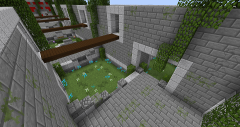When you sit down to try and come up with an idea for a map, the options available to you can feel daunting. To solve this problem, you should start with your major restrictions (As Mark Rosewater famously states, “Restrictions breed creativity”.). This usually means answering these questions:
- What gamemode?
- Who's your audience?
- How large is the map (how many players per team)?
After answering these basic questions, you can start to set creative goals and restrictions based on the sort of map you want to make. For example:
- A CTF map that focuses on two parallel lanes and rotations between them
- A CTW map with a heavy emphasis on tunneling instead of skybridge
- A DTC map that centers around contestable middle supply islands
- A Domination map that centers around close-quarters chokepoint control in a verticallly stacked layout
The defining features of your map can follow a simple concept like these, or they can be an exploration of the interaction between a few major concepts.
When it comes to implementing these concepts, you'll rarely be working from scratch. A good mapmaker will learn from the successes and mistakes of others as well as themselves. There is of course a fine line between progress and plagiarism, so your goal should be to improve upon or reinterpret concepts that you are borrowing from other maps. The important distinction to make is that you're not just taking what worked in other maps and sticking them into yours, you're examining WHY they worked and incorporating those reasons into your design.
 Verdant Corridors is known for its excessive amount of tunnels without any indication of their destination.
Verdant Corridors is known for its excessive amount of tunnels without any indication of their destination.For example, let's explore the CTF map with two parallel lanes. My first thought would be to examine maps that have done similar things, such as Verdant Corridors and more recently, Impact. I would recognize that what worked in these maps is the tough decisions that came out of spreading your players across two very distinct options, and try to improve upon the interesting scenarios that decision can create. I would look at how the overabundance of options on Verdant Corridors made it next to impossible to keep track of enemy players, and learn from that by keeping a close eye on making a manageable layout in a fundamentally cramped and separated concept.
On the topic of player spreads and routes as player choices, the mentality of considering the options of the player is extremely important to designing a good map. When you start to get into the details of where players can go and what they can and can't do, remember that a player presented with options will be weighing them based on their relative strength in the current state of the game. These options can vary wildly in context, from overall player spread to cannon designs to even simply picking a piece of cover. These decisions make up the strategic depth of your map, so it's extremely important to keep them engaging.
There are three main ways to ensure strategic decisions are compelling:
- There isn't an obvious right answer.
- If one option is clearly better than the rest it's barely a decision at all.
- Each choice has some sort of tradeoff. Good examples of this include:
- Cover options that are each strong against different angles, but none against all of them.
- Giving height advantage to an area near a hill but not the hill itself, making players chose between high ground and being able to force players off the hill in melee.
- Forcing a CTW defender to chose between staying up on top of their wall to get a better angle on skybridge, or staying near the ground to have a better angle for bowspamming someone trying to ground push.
- The relative strength of options varies based on the state of the game and the choices made by the opponent.
- When this condition is met well, you've achieved a “metagame”. Strong metagames involve players trying to plan ahead of their opponents, who are in turn trying to do the same. Designing metagames and meaningful counterplay is far beyond the scope of this guide, but if you're interested in some of the basics check out this GDC talk to learn about matchups vs raw power, and this GDC talk to learn about counterplay.
As you're designing your map and fleshing out your concepts, it's usually a good idea to sketch a model of the map to help visualize it. It doesn't have to be a paper and pencil sketch, it could be you building a smaller model ingame or even messing with a copy of an existing map to see how your ideas might affect existing ones.
Next: Construction Last: Intro